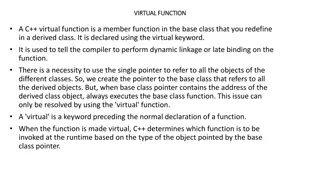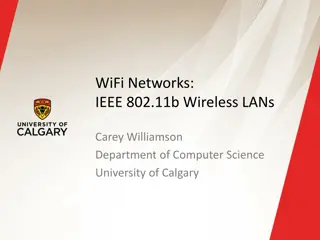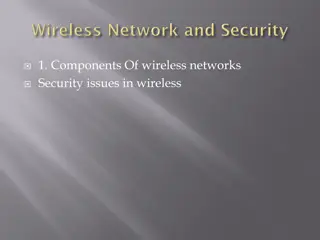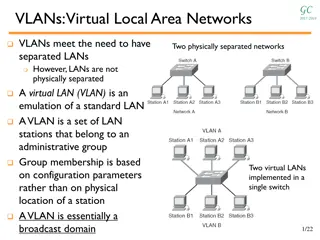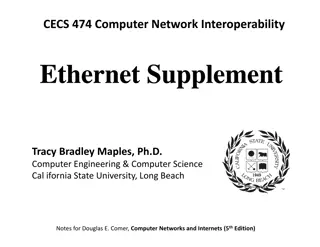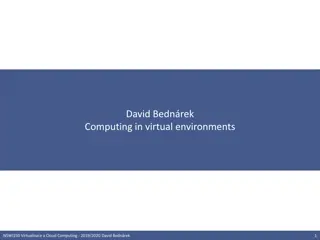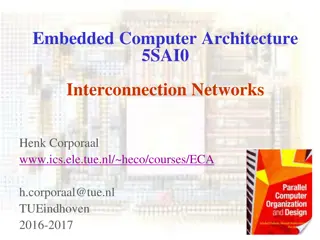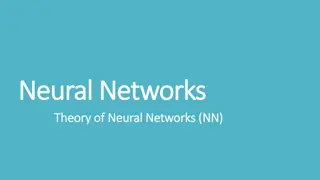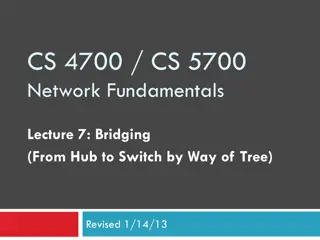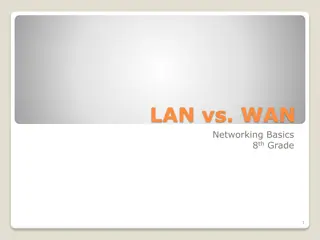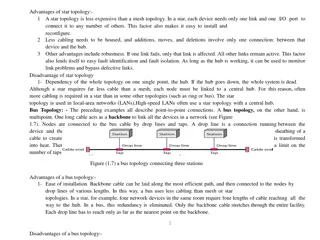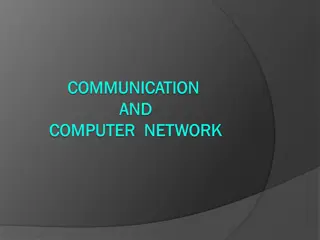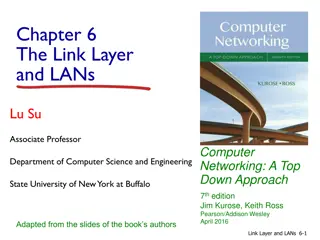Virtual LANs in Computer Networks
Virtual LANs (VLANs) enable partitioning and isolation of broadcast domains in a computer network at the data link layer. This allows network traffic to appear split between separate networks while being physically on a single network, enhancing network management efficiency and security. VLAN tagging and double tagging are advanced techniques for efficient network segmentation and traffic prioritization.
Download Presentation

Please find below an Image/Link to download the presentation.
The content on the website is provided AS IS for your information and personal use only. It may not be sold, licensed, or shared on other websites without obtaining consent from the author.If you encounter any issues during the download, it is possible that the publisher has removed the file from their server.
You are allowed to download the files provided on this website for personal or commercial use, subject to the condition that they are used lawfully. All files are the property of their respective owners.
The content on the website is provided AS IS for your information and personal use only. It may not be sold, licensed, or shared on other websites without obtaining consent from the author.
E N D
Presentation Transcript
Gilbert Detillieux, Computer Science Presented to MUUG, October 2017
7-Layer Model 7 6 5 4 (TCP, UDP) 3 (IP, Routers) 2 (Ethernet, Switches, Bridges) 1 (100BaseT, Hubs, Repeaters) Source: https://commons.wikimedia.org/wiki/File:Osi-model-jb.svg licensed under the Creative CommonsAttribution-Share Alike 3.0 Unported license
Routers, Switches, and Hubs, Oh My! Device: OSI Layer Collision Domains Broadcast Domains Hub 1 1 Bridge 2 2 Switch 2 1/port Router 3 1/port 1 1 1 1/port
What is a VLAN? A virtual LAN (VLAN) is any broadcast domain that is partitioned and isolated in a computer network at the data link layer (OSI layer 2) creating the appearance and functionality of network traffic that is physically on a single network but acts as if it is split between separate networks. In this way, VLANs can keep network applications separate despite being connected to the same physical network, and without requiring multiple sets of cabling and networking devices to be deployed. Source: https://en.wikipedia.org/wiki/Virtual_LAN licensed under the Creative Commons Attribution-ShareAlike License
VLAN Tagging (IEEE 802.1Q) adds a 32-bit field between the source MAC address and the EtherType fields Tag protocol identifier (TPID): a 16-bit field set to a value of 0x8100 Priority code point (PCP): a 3-bit field which refers to the IEEE 802.1p class of service Drop eligible indicator (DEI): a 1-bit field (congestion management) VLAN identifier (VID): a 12-bit field 0x000 and 0xFFF are reserved other values may be used as VLAN identifiers, allowing up to 4,094 VLANs Source: https://en.wikipedia.org/wiki/IEEE_802.1Q licensed under the Creative Commons Attribution-ShareAlike License
Double Tagging (802.1ad) useful for Internet service providers allow use of VLANs internally while mixing traffic from clients that are already VLAN-tagged outer (representing ISP VLAN) S-TAG (service tag) comes first inner C-TAG (customer tag) next TPID of 0x88a8 for service-provider outer S-TAG Source: https://en.wikipedia.org/wiki/IEEE_802.1Q licensed under the Creative Commons Attribution-ShareAlike License
IOS Access Mode vs Trunk Mode ! Port 1 in access mode: ! Port 24 (uplink) in trunk mode: interface GigabitEthernet1/0/1 switchport access vlan 10 switchport mode access interface GigabitEthernet1/0/24 switchport trunk encapsulation dot1q switchport mode trunk Sample Cisco IOS Configuration
Trunk Mode with VLAN Filtering ! Restricted Trunk Port: ! Define our VLAN s: interface GigabitEthernet1/0/24 switchport trunk encapsulation dot1q switchport trunk allowed vlan 10,20 switchport mode trunk vlan 10,20,30 Sample Cisco IOS Configuration
Trunk Mode with Native VLAN ! Transitional Trunk Port: ! Define our VLAN s: interface GigabitEthernet1/0/24 switchport trunk encapsulation dot1q switchport trunk native vlan 10 switchport mode trunk vlan 10,20,30 Sample Cisco IOS Configuration
VLAN Support Linux Similar mechanism to virtual interfaces (e.g. eth0:1) Parent interface (e.g. eth0) will send/receive untagged frames on native VLAN Define a separate child interface (e.g. eth0.10) per VLAN These interfaces will send/receive tagged frames for those specific VLANs Tagging done at kernel level; no direct user-level manipulation
VLAN Setup Linux Commands vconfig add eth0 10 or ip link add link eth0 name eth0.10 type vlan id 10 or nmcli con add type vlan ifname VLAN10 dev eth0 id 10 Sample Linux Commands for VLAN Configuration
VLAN Setup Red Hat ifcfg File # /etc/sysconfig/network-scripts/ifcfg-eth0.10 DEVICE=eth0.10 VLAN=yes BOOTPROTO=none ONBOOT=yes IPADDR=192.168.1.1 PREFIX=24 NETWORK=192.168.1.0 Sample Red Hat Linux ifcfg Script for VLAN Configuration
VLAN Setup Debian interfaces # /etc/network/interfaces auto eth0.10 iface eth0.10 inet static address 10.10.10.1 netmask 255.255.255.0 vlan-raw-device eth0 Sample Debian / Ubuntu Linux interfaces File for VLAN Configuration
VLAN Setup Linux / Gnome3 open the Network window, click the plus symbol, and select VLAN from the list select the parent interface from the drop-down list enter the VLAN ID enter a VLAN interface name Save Sample Gnome NetworkManager Dialogue for VLAN Configuration
Further Reading https://www.thomas-krenn.com/en/wiki/VLAN_Basics https://en.wikipedia.org/wiki/IEEE_802.1Q https://en.wikipedia.org/wiki/Multiple_Registration_Protocol https://www.cisco.com/c/en/us/tech/lan-switching/virtual-lans-vlan- trunking-protocol-vlans-vtp/tech-configuration-examples-list.html https://www.cyberciti.biz/tips/howto-configure-linux-virtual-local-area- network-vlan.html https://access.redhat.com/documentation/en- us/red_hat_enterprise_linux/7/html/networking_guide/ch- configure_802_1q_vlan_tagging https://wiki.debian.org/NetworkConfiguration#Howto_use_vlan_.28dot 1q.2C_802.1q.2C_trunk.29_.28Etch.2C_Lenny.29
This work is available under the Creative Commons Attribution-NonCommercial-ShareAlike 2.5 Canada (CC BY-NC-SA 2.5 CA) license


